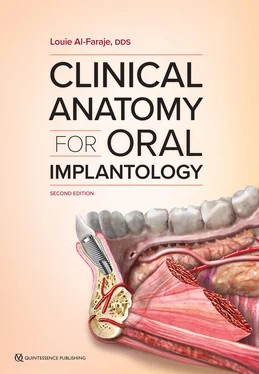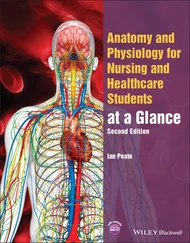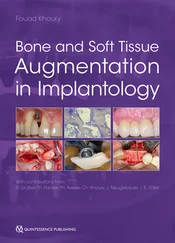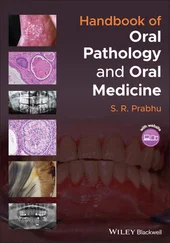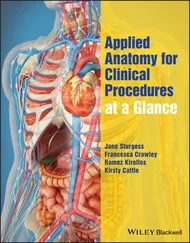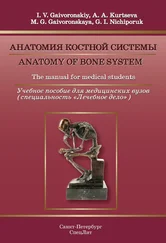Clinical Anatomy for Oral Implantology, Second Edition

Library of Congress Cataloging-in-Publication Data
Names: Al-Faraje, Louie, author.
Title: Clinical anatomy for oral implantology / Louie Al-Faraje.
Other titles: Surgical and radiologic anatomy for oral implantology
Description: Second edition. | Batavia, IL : Quintessence Publishing Co,
Inc, [2021] | Preceded by Surgical and radiologic anatomy for oral
implantology / Louie Al-Faraje ; with contributions by Christopher
Church, MD, Arthur Rathburn, LFD. [2013] | Includes bibliographical
references and index. | Summary: "Detailed illustrations and
descriptions of the anatomical areas that may be encountered during
dental implant surgery, including clinical photographs and radiographs
as well as full-page color drawings"-- Provided by publisher.
Identifiers: LCCN 2021001743 (print) | LCCN 2021001744 (ebook) | ISBN
9781647240981 (hardcover) | ISBN 9781647240974 (ebook)
Subjects: MESH: Dental Implantation, Endosseous--methods | Anatomic
Landmarks | Dental Implants | Tooth--anatomy & histology | Jaw--anatomy
& histology | Orthognathic Surgical Procedures
Classification: LCC RK667.I45 (print) | LCC RK667.I45 (ebook) | NLM WU
640 | DDC 617.6/93--dc23
LC record available at https://lccn.loc.gov/2021001743
LC ebook record available at https://lccn.loc.gov/2021001744

©2021 Quintessence Publishing Co, Inc
Quintessence Publishing Co, Inc
411 N Raddant Road
Batavia, IL 60510
www.quintpub.com
5 4 3 2 1
All rights reserved. This book or any part thereof may not be reproduced, stored in a retrieval system, or transmitted in any form or by any means, electronic, mechanical, photocopying, or otherwise, without prior written permission of the publisher.
Editor: Marieke Zaffron
Design: Sue Zubek
Production: Angelina Schmelter
Printed in China
We are respectful of and deeply indebted to the six anonymous individuals whose cadaver sections are shown in this book. They have made a donation to science that will enrich the fundamental knowledge base of human anatomy and will benefit today’s students and clinicians of oral implantology. Future generations can then build on this foundational knowledge.
I have done all in my power to preserve, protect, and maintain the dignity of these individuals. We did not know them in life but studied them in death; whoever they were, we honor their remains and dignify their gift.
To these six, our deepest thanks.
Dedication DEDICATION This book is dedicated to Ala-al-din abu Al-Hassan Ali ibn Abi-Hazm al-Qarshi al-Dimashqi, known as Ibn al-Nafis. Ibn al-Nafis was an Arab physician who is mostly famous for being the first to describe the pulmonary circulation of the blood. He was born in 1213 in Damascus. He attended the Medical College Hospital (Bimaristan Al-Noori) in Damascus. Apart from medicine, Ibn al-Nafis learned jurisprudence, literature, and theology. He became an expert on the Shafi’i school of jurisprudence and an expert physician. In 1236, Al-Nafis moved to Egypt. He worked at the Al-Nassri Hospital and subsequently at the Al-Mansouri Hospital as a chief physician. When he died in 1288, he donated his house, library, and clinic to the Mansuriya Hospital.
Preface
1 Arteries, Veins, and Innervation of the Maxilla and the Mandible
2 Muscles of Facial Expression and Mastication
3 Posterior Maxilla
4 Zygomatic Bone
5 Anterior Maxilla
6 Posterior Mandible
7 Anterior Mandible
8 Bone Density and Adjacent Teeth
9 Anatomy for Surgical Emergencies
10 Topographic Anatomy of the Maxilla and the Mandible
11 Venipuncture
Index
This book is dedicated to Ala-al-din abu Al-Hassan Ali ibn Abi-Hazm al-Qarshi al-Dimashqi, known as Ibn al-Nafis.
Ibn al-Nafis was an Arab physician who is mostly famous for being the first to describe the pulmonary circulation of the blood. He was born in 1213 in Damascus. He attended the Medical College Hospital (Bimaristan Al-Noori) in Damascus. Apart from medicine, Ibn al-Nafis learned jurisprudence, literature, and theology. He became an expert on the Shafi’i school of jurisprudence and an expert physician.
In 1236, Al-Nafis moved to Egypt. He worked at the Al-Nassri Hospital and subsequently at the Al-Mansouri Hospital as a chief physician. When he died in 1288, he donated his house, library, and clinic to the Mansuriya Hospital.
Discovery of pulmonary circulation
The theory that was accepted prior to Al-Nafis was that of Galen from the 2nd century. Galen had theorized that the blood reaching the right side of the heart went through invisible pores in the cardiac septum, to the left side of the heart, where it mixed with air to create spirit and was then distributed to the body. According to Galen, the venous system was quite separate from the arterial system, except when they came in contact through the unseen pores.
Based on his anatomical knowledge, Al-Nafis stated that:
The blood from the right chamber of the heart must arrive at the left chamber but there is no direct pathway between them. The thick septum of the heart is not perforated and does not have visible pores as some people thought or invisible pores as Galen thought. The blood from the right chamber must flow through the vena arteriosa [pulmonary artery] to the lungs, spread through its substances, be mingled there with air, pass through the arteria venosa [pulmonary vein] to reach the left chamber of the heart and there form the vital spirit.
Elsewhere in his book, he said that:
The heart has only two ventricles … and between these two there is absolutely no opening. Also dissection gives this lie to what they said, as the septum between these two cavities is much thicker than elsewhere. The benefit of this blood [that is in the right cavity] is to go up to the lungs, mix with what is in the lungs of air, then pass through the arteria venosa to the left cavity of the two cavities of the heart and of that mixture is created the animal spirit.
In describing the anatomy of the lungs, Al-Nafis stated:
The lungs are composed of parts, one of which is the bronchi; the second, the branches of the arteria venosa; and the third, the branches of the vena arteriosa, all of them connected by loose porous flesh.
He then added that:
The need of the lungs for the vena arteriosa is to transport to it the blood that has been thinned and warmed in the heart, so that what seeps through the pores of the branches of this vessel into the alveoli of the lungs may mix with what there is of air therein and combine with it, the resultant composite becoming fit to be spirit, when this mixing takes place in the left cavity of the heart. The mixture is carried to the left cavity by the arteria venosa.
Al-Nafis also postulated that nutrients for the heart are extracted from the coronary arteries:
Again, his [Avicenna’s] statement that the blood that is in the right side is to nourish the heart is not true at all, for the nourishment to the heart is from the blood that goes through the vessels that permeate the body of the heart.
Читать дальше
